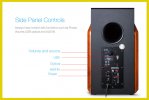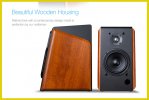My nephew had these speakers a few years back.It was sold under a different brand name here in India.I am quite sure this was priced around 80 usd.The speaker even had usb in so that you could play songs from pendrive.I can't believe Amazon is ripping people of their hard earned money.
-
WANTED: Happy members who like to discuss audio and other topics related to our interest. Desire to learn and share knowledge of science required. There are many reviews of audio hardware and expert members to help answer your questions. Click here to have your audio equipment measured for free!
You are using an out of date browser. It may not display this or other websites correctly.
You should upgrade or use an alternative browser.
You should upgrade or use an alternative browser.
Amazon Basics 80W Review (Bookshelf Speaker)
- Thread starter amirm
- Start date
Pattern
Member
- Joined
- Dec 6, 2021
- Messages
- 38
- Likes
- 53
Would you consider running a second set of measurements on a speaker post EQ in future reviews? I of course ask this not knowing if this is even possible with your machine. I think it would be insightful if it is possible.If someone is not using EQ, then they can clearly see if that setup is recommended or not. I don't see how someone can run with "recommended with EQ" and assume the same is true of not equalizing especially when flaws of the speaker response are clearly documented.
As I have repeatedly explained, equalization is my tool to evaluate the data we get out of measurements. To the extent a flaw is removed with EQ, I see no reason to not recommend the speaker based on that flaw existing.
Also, if someone is not using EQ in their room, then they are at odds with everything I am about anyway. No system without EQ has correct bass response so one way or the other, you need to have EQ. If you don't, then you are playing your own fiddle so not something I am concerned about.
- Thread Starter
- #63
Not practical. There is no way to export Roon filters. Even if there were, it would require a second set of measurements which would be as costly as testing another speaker. The simulations in software show the effect anyway.Would you consider running a second set of measurements on a speaker post EQ in future reviews? I of course ask this not knowing if this is even possible with your machine. I think it would be insightful if it is possible.
Maiky76
Senior Member
This is a review and detailed measurements of the Amazon Basics 80 Watt bookshelf speaker. I purchased it for just US $50 (pair) but current price is $342.
View attachment 174336
I put the designation "80W" as there is another speaker with the same name but with 50 watt power. This one is "higher end" with a more powerful amplifier and slanted back baffle. There is not a lot of weight to the speaker and while it looks a hair cheap, standing back from it, it looks fine. The dark circle is not a port (which is in the back) but rather a black cover for the power/status LED and receiver for remote control:
View attachment 174337
I was impressed with inclusion of Toslink digital input. Controls feel nice too. As you see, the remote is the standard one we see in countless audio products from China but has custom labels. I actually like this remote.
As you can tell from the pair of speaker terminals, they drive the slave unit passively so there is no active crossover here.
Given what I see here, I don't think this speaker's real cost is closer to its current price than what I bought it for.
Operationally I ran into a strange thing. Each measurement made by the system runs three times to gather timing and average the results. With this speaker, I would often hear it only play part of the initial sweep sometimes. It seemed like it was powering down in between sweeps which is hard to fathom as the gap is only 8 seconds or so between measurements. Reading Amazon comments, people complained about the speaker quickly going into sleep. I did not see any problem when listening to it with music.
Measurements that you are about to see were performed using the Klippel Near-field Scanner (NFS). This is a robotic measurement system that analyzes the speaker all around and is able (using advanced mathematics and dual scan) to subtract room reflections (so where I measure it doesn't matter). It also measures the speaker at close distance ("near-field") which sharply reduces the impact of room noise. Both of these factors enable testing in ordinary rooms yet results that can be more accurate than an anechoic chamber. In a nutshell, the measurements show the actual sound coming out of the speaker independent of the room.
Measurements are compliant with latest speaker research into what can predict the speaker preference and is standardized in CEA/CTA-2034 ANSI specifications. Likewise listening tests are performed per research that shows mono listening is much more revealing of differences between speakers than stereo or multichannel.
Reference axis was the center of the tweeter (aligned by eye). The grill was not used although it is a very transparent one so it should not impact the sound much. Measurement room was at 14 degrees C. Accuracy is better than 1% for almost entire audio spectrum.
Amazon Basics 80W Measurements
Acoustic measurements can be grouped in a way that can be perceptually analyzed to determine how good a speaker is and how it can be used in a room. This so called spinorama shows us just about everything we need to know about the speaker with respect to tonality and some flaws:
View attachment 174338
Note: the lower amplitude of the bass frequencies may be partially due to it cutting off the lower part of the sweep as I explained in the intro. It is not fully responsible for that though as my single, in-room measurements also show some drooping there.
Overall response is one of the most chewed up ones I have seen. Clearly there are many interfering factors there so let's look at individual driver measurements in near field:
View attachment 174339
OK, we get a lot of clarity now. Clearly the messiness between 500 Hz and 2 kHz due to port or cabinet resonances interfering with the mid-woofer's response. The crossover frequency seems quite high allowing the woofer to show its resonance around 4.5 kHz and another around 6 kHz.
Early window reflections shows much of the messiness as well:
View attachment 174340
Summing the two, we get a predicted in-room response that is quite flat (depending on how you draw the trend line):
View attachment 174341
Response is impressively flat though down 50 Hz!
Another impressive thing is the very low distortion at 86 dBSPL:
View attachment 174342
View attachment 174343
It is not very usable at 96 dBSPL as is typical of these speakers. I could hear odd tones during that sweep even with my hearing protection on.
Directivity is both terrible and OK:
View attachment 174344
View attachment 174345
The wide and relatively smooth response from the woofer makes horizontal width quite wide. But once the tweeter takes over, we get fair bit of messiness and narrowing.
Vertically it is more challenging than many 2-way speakers due to slanted back baffle stealing some of your range:
View attachment 174346
For fans of timing analysis, here are the waterfall, impulse and step responses:
View attachment 174347
View attachment 174348
View attachment 174349
Notice the latency through the system of about 14 milliseconds. All of the measurements are through the analog input by the way.
Amazon Basics 80W Listening Tests and Equalization
Given the measurements, I was ready for the worst. As a testament of how difficult and useless stand alone listening tests are, the 80W didn't sound horrible at all. It actually took a few seconds for me to realize the excess brightness but the rest of the problems were not obvious until I develop filters and tested their impact with AB tests of turning them on and off:
View attachment 174351
There is a broad shelving filter (Band 1/Teal Green) to match the mid to high frequencies to bass. I reduced the level of this as if you go by the measurements, it is too jarring in how much of the brilliance of the speaker is taken away. I put in a pair of dips to get rid of the port/cabinet resonances and final one for the woofer. All of this helped to improve clarity and balance the tonality.
Once there, a major feature of this speaker took front and center: powerful amplification together with good driver bass response meant that in near-field listening I had all the volume I wanted. This is far in excess of many studio/powered monitors can handle. There simply is no signal of distortion as you crank up the volume and are greeted with good bass to boot. There is no sub-bass to speak of but what is there is not badly distorted.
I can't emphasize the above enough. I can't use vast majority of small monitors because it is so easy to get them to crackle due to lack of amplification power. This speaker uses a single more powerful amplifier instead of splitting the budget into two lower power one. On the face of it we would think that an active crossover with dual amps is better but not when it comes at the cost of limited power. I am able to fix many of the flaws with software EQ anyway.
And oh, the large size of this box means that it portrays a much larger image than small monitors.
Once I had the EQ dialed in, I was enjoying and marveling at the fidelity of this "flawed" speaker! On my audiophile tracks it played them with nuances that I reserve for very well executed and high-end speakers.
Note that I tested the unit in near-field setting.
Conclusions
Objectively, the Amazon Basics 80W makes many classical mistakes which make you want to throw up. Fortunately many of the mistakes manifest themselves in resonances that are fixable by reducing level and thereby lowering distortion. In this regard, equalization works powerfully letting the ample dynamic range of this speaker to show off and differentiate itself from the competition. For the $50 price I paid, it is the steal of the century with EQ. Even without, if you are not bothered by somewhat bright personality (which is offset nicely by unusually flat bass response).
Overall, I am going to happily recommend the Amazon Basics 80W with equalization.
-----------
As always, questions, comments, recommendations, etc. are welcome.
Any donations are much appreciated using: https://www.audiosciencereview.com/forum/index.php?threads/how-to-support-audio-science-review.8150/
Hi,
Here is my take on the EQ.
The following EQs are “anechoic” EQs to get the speaker right before room integration. If you able to implement these EQs you must add EQ at LF for room integration, that is usually not optional… see hints there: https://www.audiosciencereview.com/...helf-speaker-review.11144/page-26#post-800725
The raw data with corrected ER and PIR:
Score no EQ: 3.1
With Sub: 5.2
Spinorama with no EQ:
- Ragged
- Resonances
- Port

Directivity:
Better stay at tweeter height
Horizontally, better toe-in the speakers by 10/20deg and have the axis crossing in front of the listening location, might help dosing the upper range.


EQ design:
I have generated two EQs. The APO config files are attached.
- The first one, labelled, LW is targeted at making the LW flat
- The second, labelled Score, starts with the first one and adds the score as an optimization variable.
- The EQs are designed in the context of regular stereo use i.e. domestic environment, no warranty is provided for a near field use in a studio environment although the LW might be better suited for this purpose.
with sub: 7.4
Score EQ Score: 5.2
with sub: 7.3
Score @amirm EQ: 4.2
with sub: 6.2
Code:
Amazon Basics Bookshelf APO EQ LW 96000Hz
December252021-111754
Preamp: -4.7 dB
Filter 1: ON HPQ Fc 52.97, 0.00, 1.25
Filter 2: ON PK Fc 97.98, 2.85, 1.10
Filter 3: ON PK Fc 298.65, -0.95, 4.96
Filter 4: ON PK Fc 697.09, 3.40, 3.36
Filter 5: ON PK Fc 823.95, -2.81, 4.01
Filter 6: ON PK Fc 1319.50, -3.59, 4.95
Filter 7: ON PK Fc 4567.36, 1.37, 1.02
Filter 8: ON PK Fc 4619.42, -2.28, 4.94
Filter 9: ON PK Fc 6193.15, -3.94, 4.95
Filter 10: ON PK Fc 7642.52, 2.43, 4.28
Amazon Basics Bookshelf APO EQ Score 96000Hz
December252021-111640
Preamp: -4.7 dB
Filter 1: ON HPQ Fc 52.97, 0.00, 1.25
Filter 2: ON PK Fc 98.23, 2.85, 1.10
Filter 3: ON PK Fc 298.15, -0.95, 4.96
Filter 4: ON PK Fc 698.09, 3.40, 3.36
Filter 5: ON PK Fc 825.95, -2.81, 3.01
Filter 6: ON PK Fc 1322.50, -3.59, 4.95
Filter 7: ON PK Fc 4974.60, 1.37, 1.02
Filter 8: ON PK Fc 4620.92, -2.54, 4.94
Filter 9: ON PK Fc 6255.20, -5.23, 4.95
Spinorama EQ LW

Spinorama EQ Score

Amirm EQ

Zoom PIR-LW-ON

Regression - Tonal

Radar no EQ vs EQ score
Large improvements

The rest of the plots is attached.
Attachments
-
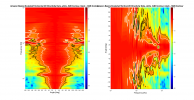 Amazon Basics Bookshelf 2D surface Directivity Contour Data.png324.6 KB · Views: 71
Amazon Basics Bookshelf 2D surface Directivity Contour Data.png324.6 KB · Views: 71 -
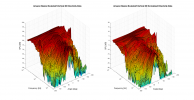 Amazon Basics Bookshelf 3D surface Vertical Directivity Data.png428 KB · Views: 66
Amazon Basics Bookshelf 3D surface Vertical Directivity Data.png428 KB · Views: 66 -
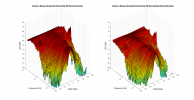 Amazon Basics Bookshelf 3D surface Horizontal Directivity Data.png420.4 KB · Views: 67
Amazon Basics Bookshelf 3D surface Horizontal Directivity Data.png420.4 KB · Views: 67 -
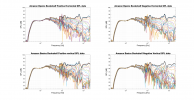 Amazon Basics Bookshelf Raw Directivity data.png487.3 KB · Views: 75
Amazon Basics Bookshelf Raw Directivity data.png487.3 KB · Views: 75 -
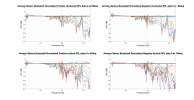 Amazon Basics Bookshelf Normalized Directivity data.png331 KB · Views: 72
Amazon Basics Bookshelf Normalized Directivity data.png331 KB · Views: 72 -
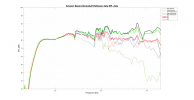 Amazon Basics Bookshelf Reflexion data.png149.3 KB · Views: 60
Amazon Basics Bookshelf Reflexion data.png149.3 KB · Views: 60 -
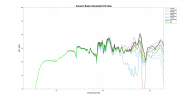 Amazon Basics Bookshelf LW data.png151.9 KB · Views: 63
Amazon Basics Bookshelf LW data.png151.9 KB · Views: 63 -
Amazon Basics Bookshelf APO EQ LW 96000Hz.txt532 bytes · Views: 62
-
Amazon Basics Bookshelf APO EQ Score 96000Hz.txt489 bytes · Views: 58
Yes, I’d rather see more speakers tested.
Klippel time is precious.
Klippel time is precious.
bennybbbx
Addicted to Fun and Learning
This is a review and detailed measurements of the Amazon Basics 80 Watt bookshelf speaker. I purchased it for just US $50 (pair) but current price is $342.
View attachment 174336
I put the designation "80W" as there is another speaker with the same name but with 50 watt power. This one is "higher end" with a more powerful amplifier and slanted back baffle. There is not a lot of weight to the speaker and while it looks a hair cheap, standing back from it, it looks fine. The dark circle is not a port (which is in the back) but rather a black cover for the power/status LED and receiver for remote control:
View attachment 174337
I was impressed with inclusion of Toslink digital input. Controls feel nice too. As you see, the remote is the standard one we see in countless audio products from China but has custom labels. I actually like this remote.
As you can tell from the pair of speaker terminals, they drive the slave unit passively so there is no active crossover here.
Given what I see here, I don't think this speaker's real cost is closer to its current price than what I bought it for.
Operationally I ran into a strange thing. Each measurement made by the system runs three times to gather timing and average the results. With this speaker, I would often hear it only play part of the initial sweep sometimes. It seemed like it was powering down in between sweeps which is hard to fathom as the gap is only 8 seconds or so between measurements. Reading Amazon comments, people complained about the speaker quickly going into sleep. I did not see any problem when listening to it with music.
Measurements that you are about to see were performed using the Klippel Near-field Scanner (NFS). This is a robotic measurement system that analyzes the speaker all around and is able (using advanced mathematics and dual scan) to subtract room reflections (so where I measure it doesn't matter). It also measures the speaker at close distance ("near-field") which sharply reduces the impact of room noise. Both of these factors enable testing in ordinary rooms yet results that can be more accurate than an anechoic chamber. In a nutshell, the measurements show the actual sound coming out of the speaker independent of the room.
Measurements are compliant with latest speaker research into what can predict the speaker preference and is standardized in CEA/CTA-2034 ANSI specifications. Likewise listening tests are performed per research that shows mono listening is much more revealing of differences between speakers than stereo or multichannel.
Reference axis was the center of the tweeter (aligned by eye). The grill was not used although it is a very transparent one so it should not impact the sound much. Measurement room was at 14 degrees C. Accuracy is better than 1% for almost entire audio spectrum.
Amazon Basics 80W Measurements
Acoustic measurements can be grouped in a way that can be perceptually analyzed to determine how good a speaker is and how it can be used in a room. This so called spinorama shows us just about everything we need to know about the speaker with respect to tonality and some flaws:
View attachment 174338
Note: the lower amplitude of the bass frequencies may be partially due to it cutting off the lower part of the sweep as I explained in the intro. It is not fully responsible for that though as my single, in-room measurements also show some drooping there.
Overall response is one of the most chewed up ones I have seen. Clearly there are many interfering factors there so let's look at individual driver measurements in near field:
View attachment 174339
OK, we get a lot of clarity now. Clearly the messiness between 500 Hz and 2 kHz due to port or cabinet resonances interfering with the mid-woofer's response. The crossover frequency seems quite high allowing the woofer to show its resonance around 4.5 kHz and another around 6 kHz.
Early window reflections shows much of the messiness as well:
View attachment 174340
Summing the two, we get a predicted in-room response that is quite flat (depending on how you draw the trend line):
View attachment 174341
Response is impressively flat though down 50 Hz!
Another impressive thing is the very low distortion at 86 dBSPL:
View attachment 174342
View attachment 174343
It is not very usable at 96 dBSPL as is typical of these speakers. I could hear odd tones during that sweep even with my hearing protection on.
Directivity is both terrible and OK:
View attachment 174344
View attachment 174345
The wide and relatively smooth response from the woofer makes horizontal width quite wide. But once the tweeter takes over, we get fair bit of messiness and narrowing.
Vertically it is more challenging than many 2-way speakers due to slanted back baffle stealing some of your range:
View attachment 174346
For fans of timing analysis, here are the waterfall, impulse and step responses:
View attachment 174347
View attachment 174348
View attachment 174349
Notice the latency through the system of about 14 milliseconds. All of the measurements are through the analog input by the way.
Amazon Basics 80W Listening Tests and Equalization
Given the measurements, I was ready for the worst. As a testament of how difficult and useless stand alone listening tests are, the 80W didn't sound horrible at all. It actually took a few seconds for me to realize the excess brightness but the rest of the problems were not obvious until I develop filters and tested their impact with AB tests of turning them on and off:
View attachment 174351
There is a broad shelving filter (Band 1/Teal Green) to match the mid to high frequencies to bass. I reduced the level of this as if you go by the measurements, it is too jarring in how much of the brilliance of the speaker is taken away. I put in a pair of dips to get rid of the port/cabinet resonances and final one for the woofer. All of this helped to improve clarity and balance the tonality.
Once there, a major feature of this speaker took front and center: powerful amplification together with good driver bass response meant that in near-field listening I had all the volume I wanted. This is far in excess of many studio/powered monitors can handle. There simply is no signal of distortion as you crank up the volume and are greeted with good bass to boot. There is no sub-bass to speak of but what is there is not badly distorted.
I can't emphasize the above enough. I can't use vast majority of small monitors because it is so easy to get them to crackle due to lack of amplification power. This speaker uses a single more powerful amplifier instead of splitting the budget into two lower power one. On the face of it we would think that an active crossover with dual amps is better but not when it comes at the cost of limited power. I am able to fix many of the flaws with software EQ anyway.
And oh, the large size of this box means that it portrays a much larger image than small monitors.
Once I had the EQ dialed in, I was enjoying and marveling at the fidelity of this "flawed" speaker! On my audiophile tracks it played them with nuances that I reserve for very well executed and high-end speakers.
Note that I tested the unit in near-field setting.
Conclusions
Objectively, the Amazon Basics 80W makes many classical mistakes which make you want to throw up. Fortunately many of the mistakes manifest themselves in resonances that are fixable by reducing level and thereby lowering distortion. In this regard, equalization works powerfully letting the ample dynamic range of this speaker to show off and differentiate itself from the competition. For the $50 price I paid, it is the steal of the century with EQ. Even without, if you are not bothered by somewhat bright personality (which is offset nicely by unusually flat bass response).
Overall, I am going to happily recommend the Amazon Basics 80W with equalization.
-----------
As always, questions, comments, recommendations, etc. are welcome.
Any donations are much appreciated using: https://www.audiosciencereview.com/forum/index.php?threads/how-to-support-audio-science-review.8150/
The long waterfall decay happen because the klippel seem always set the beginning of the watefall diagram to 0 ms. but on this speaker can see in step response that it begin at 14,35 ms. other speakers you test begin also not on 0 ms. in REW there is a function estimate IR delay. when choose this it set automatic the begin of the impulse to 0 ms and then waterfall is correct too
I think recommendation with EQ is ok, as long as it’s clearly stated, separated from the real ”score” and when panthers for both are included. 
But it’s still a problem when comparing to older reviews, where much better speakers did not get any recommendation.
Fixing a bad design in software doesn’t really make the product better, but it’s very useful information for owners.
But it’s still a problem when comparing to older reviews, where much better speakers did not get any recommendation.
Fixing a bad design in software doesn’t really make the product better, but it’s very useful information for owners.
Last edited:
beagleman
Major Contributor
I hate to say this, and not meant to be offensive to anyone at all, but I would love to see more time to speakers of all types, and less time with DACs. I know some want to see more electronics and so on, but I feel burnt out on them. (Crouching.....)Yes, I’d rather see more speakers tested.
Klippel time is precious.
I have been joking about "Better Living Thru Chemistry" for decades… even including what may go inside our BLT sandwiches!
Appears that conspicuous consumption (which tolerates our society's penchant for added chemicals in everything we use), is becoming rampant even in the audio industry and shamefully so; within the top-tier audio circles, like ASR.
It's no joke >> "Better Living ThruChemistry Equalization" << It's has become mainstream and borderline snake-oil of the synthetic kind!
Appears that conspicuous consumption (which tolerates our society's penchant for added chemicals in everything we use), is becoming rampant even in the audio industry and shamefully so; within the top-tier audio circles, like ASR.
It's no joke >> "Better Living Thru
fcc records show they are manufactured by SHENZHEN FENDA TECHNOLOGY CO., LTD and these speakers probably go under another name F&D R60BT
They mention DSP at their product page, was it stripped together with USB input for Amazon's "R60BTUS" model..?fcc records show they are manufactured by SHENZHEN FENDA TECHNOLOGY CO., LTD and these speakers probably go under another name F&D R60BT
Btw. they are sold for 95 Euros here in central EU.
Out of curiosity:
What types of active-circuitry (e.g. cross-over, amp, ac/dc conversion) is contained within each speaker?
Belongs in the discussion << me thinx!
Those are my fave kinda 'binding posts'!
Edit: I fail to find this speaker at the amazon website. Some Edifiers, SingingWoods[?], and Beasties[sic] for active speakers but that's it.
What types of active-circuitry (e.g. cross-over, amp, ac/dc conversion) is contained within each speaker?
Belongs in the discussion << me thinx!
Those are my fave kinda 'binding posts'!
Edit: I fail to find this speaker at the amazon website. Some Edifiers, SingingWoods[?], and Beasties[sic] for active speakers but that's it.
Last edited:
For powered/active speakers to have less than ideal FR is unforgivable. There are chips (all-in-one) which used by companies like Edifier, with built-in PEQ, they dial them during tuning and release a near perfect product. Why other manufacturers still didn't catch up - beyond me!
- Joined
- Aug 3, 2018
- Messages
- 574
- Likes
- 493
You know, because it's just the amps that are the problem.
Sorry, had to...
a terrible speaker that I would not have for free as I don't want to fill up my house with tat I'll never use.
EQ is all very well but aren't you supposed to start with a speaker that already has a near flat on and off axis response? Isn't EQ supposed to fix the problems with the room/speaker interface and not the speaker itself?
I'm only on page 150 of Toole's book so maybe I've not got to the bit where he says 'Just buy a crap speaker and EQ it, job done.'
I know it is the season of goodwill to all men but this review is far too kind whereas in the past I've thought the reviews were often a bit too brutal. What's the deal?
EQ is all very well but aren't you supposed to start with a speaker that already has a near flat on and off axis response? Isn't EQ supposed to fix the problems with the room/speaker interface and not the speaker itself?
I'm only on page 150 of Toole's book so maybe I've not got to the bit where he says 'Just buy a crap speaker and EQ it, job done.'
I know it is the season of goodwill to all men but this review is far too kind whereas in the past I've thought the reviews were often a bit too brutal. What's the deal?
musicforcities
Senior Member
- Joined
- Sep 18, 2021
- Messages
- 422
- Likes
- 476
They sure look like some of Edifier’s models. And Edifier does manufacture products for other brands I believe or at least collaborated (eg, there is a model Edifier and EarFun wireless earbuds that are exactly the same except the earfun does have an app and one of the buttons has a different function. Simply a different Firmware)....This is definitely made by Edifier isn't it...?
Similar threads
- Replies
- 331
- Views
- 45K
- Replies
- 233
- Views
- 34K
- Replies
- 310
- Views
- 60K
- Poll
- Replies
- 91
- Views
- 24K
- Replies
- 149
- Views
- 29K

